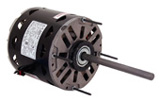
Here is an example of a PSC design that is more efficient than a previous design, and uses about 14 percent few amps. If the two motors were compared just based on amps, it might be incorrectly concluded that the previous design was a stronger motor, which is not the case.
A sleeve bearing’s entire purpose in life is to maintain a continuous layer of lubricating oil on the surface of the motor shaft. In operation, the oil flows from a reservoir to the feeder wick which rides right on the shaft. As the shaft rotates, the feeder wick pumps a microscopically thin layer of oil from the reservoir down onto the shaft. The oil flows down the shaft until it hits the “flinger” on the end which returns the oil to the reservoir.
At the same time, the sleeve bearing circulates that oil to remove any contaminants from the lubricant. Even under the best of circumstances, there are moments when the shaft is rotating that metal-to-metal contact occurs. Infinitesimal fragments of metal break off, and the oil helps move those contaminants into the bearing’s reservoir where they are filtered out by the wicking material.
So what causes mechanical breakdowns in what is essentially a closed lubricating system? The most common enemies of bearings are water (that can interrupt the flow of oil to the shaft), solvents, or the wrong lubricant.
As a rule of thumb, any type of oil that is labeled “motor oil” is okay to use as a lubricant. Detergent oils are acceptable as well; the detergents will not harm the motor’s windings. Avoid other lubricants - and tell your customers not to attempt to lubricate their motor with anything but motor oil.
You would be amazed at the types of lubrication well-meaning but untrained people try to use in electric motors. One of our quality managers once received a failed motor from a health spa that smelled strongly of coconut. No one could figure out the source of failure until they began testing the lubrication. Turns out the customer had attempted to use BenGay® cream (coconut scented of course) to lube the bearings. Smelled great - didn’t work. Other equally unsuccessful lubricants I’ve seen have included petroleum jelly, transmission fluid, and cooking oil.
Another thing to remember to tell your customers is to avoid using chlorinated solvents or industrial degreasers such as WD-40® as lubricants. The solvents can attack and destroy the insulation in the windings leading to motor failure.
Water or moisture will often get into the bearing system if the flinger is damaged or left out of the bearing. The flinger, in case you’re unfamiliar with the term, is the little plastic piece that is always left over when you take apart a motor and put it back together again. Seriously, this little piece of plastic is essential in maintaining the controlled trap system and keeping oil in circulation in the bearing system.
It may seem totally illogical, but a common form of field failure is from applying too much lubrication to a motor. Factory-fresh motors with sleeve bearing systems are always properly lubricated. Since it is essentially a closed system, there is no chance the oil will leak out during shipping or installation, so avoid the temptation to oil the motor when you put it in. When you apply too much lubrication (especially to the sleeve bearing systems in smaller electric motors), the oil bypasses the bearing flinger and dissipates throughout the motor. Too much lubrication causes oil circulation to exit the “closed loop” within the bearing system, and the bearing “freezes up.”
Another potential problem you may encounter in the field is bearing stress caused by excess tension on the belts used in belt-driven applications. The excessive tension tends to pull the shaft in the direction of the bearing window. If the belt happens to cover the bearing window, it decreases the bearing surface area (and its ability to circulate oil) by up to two-thirds. The result is increased risk of overload. In addition to decreasing the belt tension, you can also rotate the motor to keep the bearing window away from the belt.
Remember that heat kills motors, and sleeve bearings help to reduce the amount of heat the motor generates. Proper care and maintenance of sleeve bearings can help to prolong the life and service of your customers’ motors.
Publication date:07/07/2008

Report Abusive Comment